Scouting is an incredibly important thing in Football Manager. So, I thought it might be a good idea – especially with the influx of new players coming in with Christmas – to go through how I scout and why I do things the way I do. Hopefully I can help a couple of people out. Fair warning, it’s a long one.
Scouting got a bit of an overhaul in last year’s release – FM18 – and FM19 saw an expansion of that new direction and vision. Personally, I like this new direction and firmly believe that it makes scouting a lot easier to do, as long as you know how to do it – which for me means using scouts and their reports as an introduction, and then using your own analysis to make a final decision on a player.
Moving into Ragnar’s third season at Greuther, he decided that he was ready to take more of a hand in recruitment at the club, took that responsibility away from the Director of Football and set about creating the parameters that he wanted to use to identify – and potentially sign – new talent.
His third season, and first in the Bundesliga, was a qualified success (there’s a post coming soonish, I promise) and we’re now about halfway through the Rückrunde in his fourth season at the club, and he’s finally got his recruitment team set up the way he wants and has a small database of players he’s very interested in.
This post is the story of how he got there, plus the reasoning behind why he’s doing the things he is and how it can help you in your own recruitment.
As an initial disclaimer, this is not a quick fix. You will not see results immediately. It’s taken Ragnar roughly 18 months to build up a shortlist of interesting players. I also play on an advanced database with most central European leagues loaded, for a total of over 100,000 players in the database. Mileage with different database sizes will absolutely vary.
First up, let’s think about what those report cards you get in the scouting meeting email look like. In terms of how much information you can see through the various tabs, there’s quite a lot there but it doesn’t actually give you that much in depth information about a player or how they’re performing. They can for sure point out someone you might want to take a further look at, but they themselves don’t provide that further look.
And this is why I do what I do. So, first off, let’s have a look at that report card.
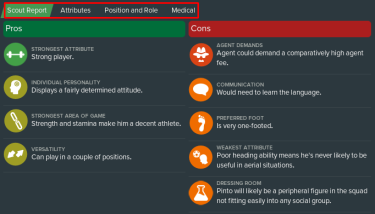
We’re going to be focusing on central defenders in this piece, so what we have there on the left is the scouting report card for a CB I just picked out of a meeting.
At the top, I’ve highlighted the different tabs you can click on to see… well, what it tells you you’ll be looking at, really.
Straight away, I’m looking at those cons and noting that he’s not great at heading and is very one footed. For a lower mid-table club that likes to play out from the back, both of these things are potential issues for me. He doesn’t speak German which can mess with communication on the pitch. So, straight away, I’m probably not going to sign him. But he does have some good pros and you can train someone to make better use of their weaker foot and be better in the air. And language courses exist.
So far, we’ve not really learned all that much. Next up, click through the other tabs to see if his role fits what you use and if he has recurring medical problems.
And that, really, is the extent of these cards – they do also show a rough idea of potential and current ability, as well as how well scouted a player has been – and that’s why I only ever use them as a jumping off point. Someone with good pros, few cons (or easily solved cons) and no medical issues is someone I want to take a better, longer look at.
I use what I’m probably incorrectly calling ‘holistic’ scouting and recruitment for this, which for me means is that I look to sign players that fit an overall type for the club and who also fit into a position specific archetype based on attribute spread and performance over a given period of time. So, for me, scouting and recruitment starts with taking a look at my own squad.
In the winter of last season, I noticed that we were having significant issues at the back in terms of mistakes made and losing aerial duels. So I went out, found a commanding centre back that is also very capable with the ball at his feet, and brought in Benedikt Gimber from Ingolstadt.

First off: From his stats you can see that he’s fixed that problem in our fourth season, thus making our defence that much more solid. But for now, let’s walk through my custom view and why I find it so helpful.
First of all, personalities. It’s very important to have a lot of similar, positive personalities at the club in general to help with overall cohesion, training performance, development and so on. Next up, we have the attributes that the game itself says are important for being a central defender. The five in the separators are the five ‘DNA’ attributes I look for in every player in my squad. The rest is pretty self explanatory – just go through the statistics options in ‘customise view’ and add the ones you think are important for each position.
Looking at all of that, we can see who my strongest defenders are in terms of key attributes and work out via the statistics who is a liability and who could well be a stronger player than those attributes might suggest.
For me, looking at that, David Carmo is my weakest defender. Yes, he’s better in the air than Maximilian Bauer and Michel Buijs and has better DNA ratings, but his anticipation is also considerably lower – where for both Bauer and Buijs it can help cover their slight deficiencies – and, importantly, they also have a greater potential to improve in that area.
The stats would seem to back that up so far this season, and he also makes a lot of mistakes when compared to the others after the minutes played have been balanced across all players. So we need to think about replacing him.
We know now that we need to find ourselves a centre back. Cool. How do we do that? We hit up our scouting team.
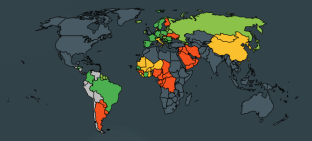
The first thing I do, before I even look at the quality of the recruitment team, is look at where our bastions of scouting knowledge are. Why? Because not every team can bring in top quality scouts by default, so you need to know which areas you know the best so you can exploit this knowledge.
For Greuther, as a fairly unremarkable (at the moment, anyway) German club, that concentration of knowledge is Europe and Scandinavia with a little bit of Russia and South America thrown in. So, straight away, I’m looking to scout European nations predominantly because that’s where most of our knowledge is, and occasionally send a guy to Brazil to see if there’s anything worth looking at over there.
Cool. Okay. So what does my scouting team look like? First of all, hit the ‘Staff’ tab from the menu on the side and see how it compares to the rest of the league to give you a rough idea of what you’re working with.
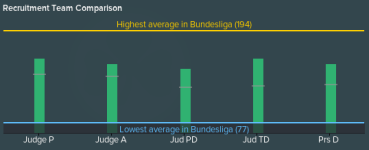
From this, you can see that despite a complete rebuild of Ragnar’s scouting and data analysis teams, we’re only just above average in terms of the league. Does this mean his scouts are bad? No. Does it mean we have to work harder to identify talent? Absolutely.
He also doesn’t have anywhere near as many scouts to work with as the top teams in the league – he’s only allowed to employ six at present, and the board are refusing to increase this – which in turn limits the area that he can scout effectively. This means he needed to take a look at his scouting team in more detail and where their personal knowledge areas are.
From the dropdown on that screen, select ‘Scouting & Transfers Team’.

You’ll see something that looks a bit like the above image, just without the view I’ve put on it and without the scouts and their key attributes highlighted.
As you can see, his scouting team is actually really very good and the only thing holding them back in terms of the league averages is that we’re not allowed to have a lot of them. All in all, we can live with that and we can find a way to make the best use of them. We do that with custom assignments.

First off, Steve Harvey has a 15 for tactical knowledge so he’s given the task to scout the next opposition. That’s his job – the team we play next, he doesn’t find players. This leaves us five scouts left to work with. Why five? Because the Chief Scout exists to scout the players my other scouts find. That’s all he does. He’s my best scout, so I trust his opinion more than the others.
Scouting Germany makes perfect sense as that’s the country that Greuther are based in, so that one seems like a good idea. The others were chosen from a combination of being geographically close to Germany – and thus meaning the impact of a a player’s adaptability is lessened (personal theory, not proven) – and being leagues that are loaded into my database – meaning that they have a deeper pool of players.
In terms of how we’ve set up each assignment, they’re looking for players based in that nation under the age of 25 and who possess a minimum of 11 in my five DNA attributes – Determination, teamwork, work rate, natural fitness and stamina.
These scouts will go out and send back reports on players they’ve found that fit these parameters and in turn, those reports will start to appear in my scouting meeting emails, bringing us neatly back to the report cards and where to go from there. As you can see by the number of reports at present, this takes time. As it stands, they’ve only been going a couple of months.
Right, so. We’ve looked out our recruitment team, set up their assignments, and they’re sending reports through to us via email. We’ve used what I mentioned above in terms of a first glance look at a player to see if they’re worth further investigation. What do we do now?
We get intense with shortlists.
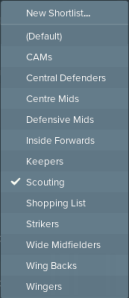
In a post for last year’s game, I talked about how I set up my bloated scouting team as a series of internal checks and balances using multiple shortlists to sort the wheat from the chaff.
As you can see, I’m still using a lot of shortlists but instead of being related to scouting ‘levels’ they’re instead based on the position of the player in question, with the exception of the ‘Scouting’ and ‘Shopping List’ shortlists.
How it works is quite simple – every player I like the look of from the scout report is put in the Scouting shortlist until I have 100% scouting knowledge of that player. If I still like the look of them, they then get moved to the position specific lists where I monitor them over the course of at least half a season.
Why half a season? Because that way you can have a look at their statistics and have a better idea of how it is they actually perform on match day, and you’ve built up a good period of time to be able to judge them on. I prefer using a full season, personally, if it’s at all possible. This also means more custom views!
Finally, if I really like them and think they can add something to the team in some way, they get shifted to the Shopping List shortlist so I can keep my transfer window targets in one place and close to hand.

This default list for everyone functions as a second glance at the player, giving me an idea as to whether or not a player works in terms of DNA and finances. The statistics displayed reflect this with generalised picks for outfield players only. I’ve highlighted the ones specific for central defenders as I see them.
Some players won’t move from here to the dedicated Central Defenders list, but one that looks like he might is Valentin Antov. I need to have a longer look at Federico Cella, but he also looks promising at this early stage.

If either one of them looks good, they’ll join this group of players where we can take a more in depth look at how they play and how they might develop. This view is tailored specifically for central defenders and still shows my chosen club DNA as another comparison tool.
I recommend that, if you decide to implement a view like this to scout players, you do not use total numbers of tackles, headers, interceptions etc – or if you do, also make sure you have the per game/per 90 minutes ratios, and overall completion ratios, included. Why? Because different teams play different ways. Using tackling as an example, consider how many tackles Guardiola’s Manchester City side makes compared to say the Stoke team under Tony Pulis.
In terms purely of tackles completed, the Stoke defenders will have vastly inflated numbers where Aymeric Laporte will look lightweight, something which – with the greatest of respect to the Stoke players – is completely false. Instead, knowing how many of those tackles have been successful is the important metric.
From that view, we can also see that – purely in terms of finances – the two players we could realistically make a move for are either Gabrijel Vidakovic or Andrea Hristov. This is where the choice becomes a hard one, because Hristov is – based on his stats so far – by far the better choice, as well as being much better in the tackle than Vidakovic. But he also has much, much less room to grow due to his scouted potential ceiling and his age. So from here, we go to player comparisons.
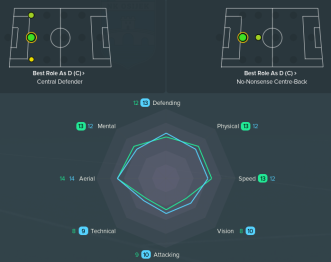
From this, we can see that in terms of the general spread of their attributes they’re actually pretty similar.
Vidakovic (green) is better mentally, physically and in terms of speed and they tie in their aerial ability with Hristov (blue) winning out in the other areas up for comparison.
In terms of preferred role, we also learn that Vidakovic is ideally a central defender with Hristov preferring a more no nonsense centre back kind of role. He is, though, equally comfortable as a central defender but it’s still something worth taking note of.
From the positions and roles tab shown on that screen just above the best role icon, we also learn that Vidakovic is also better with his weaker foot than Hristov is and that’s a handy bit of information if, like Ragnar, you play a system that plays out from the back and therefore requires your central defenders to be as comfortable as possible on the ball from either side.

This is where it gets interesting and where, ultimately the final decision gets made.
For me, based on this comparison and taking his attributes into account, Vidakovic (green) is the better prospect than Hristov (blue). I’m not looking for someone that’s going to step into our defence and be a beast, I’m looking for a rotational option that has the potential to develop into a first team player – or at least a better squad player – and I feel that Vidakovic has the better chance to do that.
His DNA score (obtained by adding the attributes together and dividing by five to get a score out of twenty) is only marginally worse than Hristov’s, making it negligible in my opinion, but his positioning, bravery and strength are all considerably better than Hristov’s – areas that are important for a central defender. His lower technical abilities can be improved via coaching and game time, so they don’t worry me as much as they might were he older than 19.
He also costs significantly less money than Hristov, and as a fairly well established Bundesliga club the minute he signs for Greuther his market value is going to skyrocket – meaning that even if he doesn’t work out at the club I’ll be able to make a decent profit on him.

So, to sum up, scouting is one of those things that genuinely isn’t really that hard. But to do it ‘right’, to get the best results and to bring in the sort of players that will make your club more cohesive, will improve the dressing room atmosphere and will improve your match day squad, you need to take your time and put in the work.
In no way am I saying that the only way to scout is to put in as much work and make it as complicated as I do – if you do, it’s going to be a hard slog and a lot of work, fair warning. I simply find this area of the game to be, for me, one of the most rewarding. After a few seasons it’s easy to build a team that win most games and subsequently most things. Identifying the next generation of talent is something that’s always a challenge.
Putting in more effort, really approaching scouting seriously and creating ways for you to form your own opinion independent from what your scouts say, also gets increasingly important the further down the football pyramid you get where you don’t have the funds – or skilled scouts – required to just sign the next Messi or whoever, slot them in your team and then profit.
You need to know how best to spend your money and how to spend it in a way that is going to make your chosen team more competitive and therefore more successful.
As a final example before I leave you, let me show you Kevin Cortez.
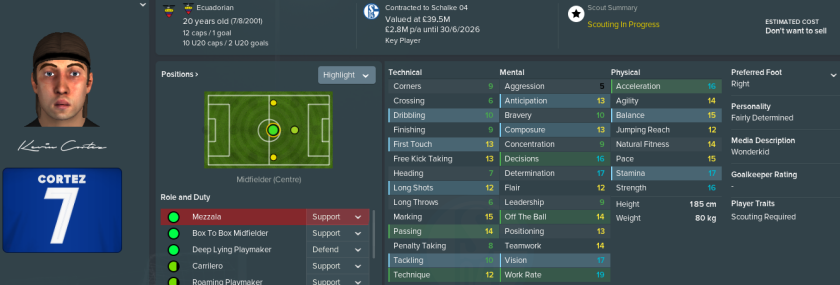
As you can see, he currently plays his football at Schalke, is worth close to £40mil and that he’s very good indeed. What that image doesn’t show is that he used to play for Greuther and that Ragnar signed him for pennies in the season he won the 2. Bundesliga.

He played that season, helped Greuther get promoted and then played their first season in the Bundesliga. In the summer, Schalke met his release clause and Greuther pocketed a healthy profit that was used to help strengthen the squad, improve the training and youth facilities and start work expanding their stadium’s capacity.
Are all of your signings going to work out like this? No. Of course not. But if you are able to scout players in a way that makes it easier to identify talented young players and then sign them on the cheap, it makes it that much more likely that you can jump on the bandwagon of the ‘Ajax model’ of developing youth, selling them at a massive mark up and then repeating the process as the club grows stronger and stronger financially. All while seeing your squad grow stronger and stronger as time goes on.
Hope you enjoyed, really hope you find it helpful, and thanks for sticking with me through a much longer piece than I intended this to be.

Good in-depth article. Thanks and well done
I absolutely love The Saga. Well-written and wise stuff. Thank you!
Anyway, I can get my hands on your custom views that you share in this article?